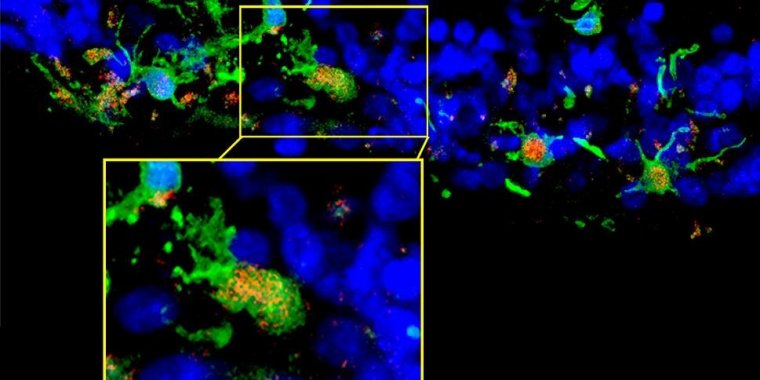| Health / Health News |
Immune system can slow degenerative eye disease
A new study shows that the complement system, part of the innate immune system, plays a protective role to slow retinal degeneration in a mouse model of retinitis pigmentosa, an inherited eye disease.

Retinal sections from a patient with retinitis pigmentosa show microglia (green) migrating into the photoreceptor layer (blue) once degeneration had begun. Inset shows microglia expressing C3 (red), which occurred in the context of photoreceptor degeneration. Photo: NEI
This surprising discovery contradicts previous studies of other eye diseases suggesting that the complement system worsens retinal degeneration.
Retinitis pigmentosa is an incurable and unpreventable blinding eye disease that affects 1 in 4,000 people.
“Much research is devoted to studying therapies that attempt to alter the immune system’s role in inherited diseases such as retinitis pigmentosa because such treatments would have broad applicability, regardless of a patient’s causative mutation,” said the study’s principal investigator Wai T Wong, M.D., Ph.D., chief the Neuron-Glia Interactions in Retinal Disease Section at NEI.
In previous studies, activation of the complement system, which mediates some aspects of inflammation, worsens damage in age-related macular degeneration (AMD), a leading cause of blindness in people age 65 years and older.
The current study involving retinitis pigmentosa underscores the notion that the complement system may in fact exacerbate or curb retinal degeneration depending on the context. Appreciating this complexity is important for guiding the development of therapies that target the complement immune system to treat degenerative diseases of the retina.
Scientists monitored the genetic expression of the complement system in a transgenic mouse model of retinitis pigmentosa. They found that upregulation of complement expression and activation coincided with the onset of photoreceptor degeneration. What’s more, this upregulation occurs in the exact location of the degeneration.
Using the retinitis pigmentosa mouse model, the researchers examined the role of C3 and CR3, the central component of complement and its receptor, by comparing mice with genetically ablated C3 or CR3 to mice with normal expression. They found that the absence of C3 or CR3 made degeneration worse.
Rod photoreceptors, the light-sensing cells that die off first in retinitis pigmentosa, were precipitously lost along with a surge in the expression of neurotoxic inflammatory cytokines.
They pieced together that C3 gets secreted by microglia, trash-collecting cells that in a healthy retina clear away dead cells by phagocytosis to keep the tissue working properly. Once secreted, C3 lands on dead photoreceptors labeling them for destruction and removal.
The receptor, CR3, recognizes the C3 markers and conveys the information to microglia. Breakdown of this C3-CR3 interaction results in a decreased ability of microglia to phagocytose dead photoreceptors, which then accumulate in the retina, stimulating greater inflammation and degeneration.
However, in the context of AMD, harmful effects observed from complement activation have spurred clinical trials testing complement inhibitors. The findings suggest that this approach may be appropriate for some disease scenarios, but may induce complex responses in other disease scenarios by inhibiting helpful and homeostatic functions of inflammation. (National Institutes of Health)
YOU MAY ALSO LIKE




